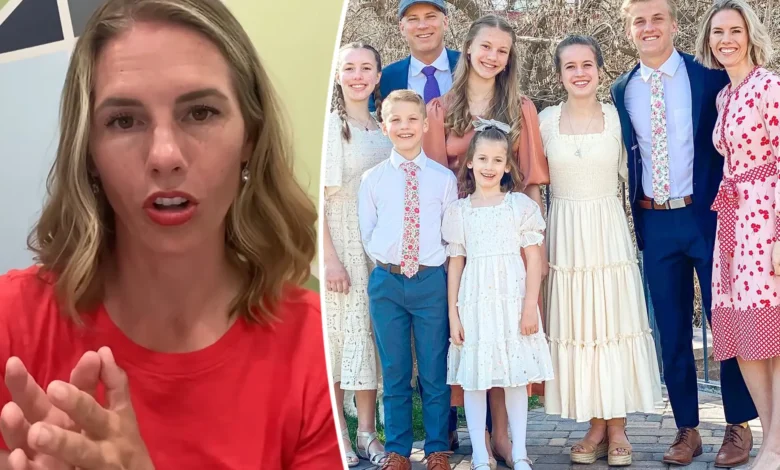The Rise and Fall of Ruby Franke Kids A Deep Dive into Her Family and Controversies

Introduction
Ruby Franke Kids in the vast realm of social media influencers, few stories are as compelling and cautionary as that of Ruby Franke. Once celebrated for her family-centric YouTube channel, “8 Passengers,” Ruby’s journey from online stardom to criminal conviction offers a profound insight into the complexities of digital fame, parenting, and personal boundaries Ruby Franke Kids .
Who is Ruby Franke?
Ruby Franke, born Ruby Griffiths on January 18, 1982, in Utah, emerged as a prominent figure in the world of family vlogging. Alongside her husband, Kevin Franke, a former assistant professor of engineering at Brigham Young University, Ruby chronicled the daily lives of their six children: Shari, Chad, Abby, Julie, Russell, and Eve. Ruby Franke Kids family’s Mormon faith often underscored their content, emphasizing traditional values and the nuances of raising a large family.
The “8 Passengers” YouTube channel, launched in early 2015, quickly gained traction. Viewers were drawn to the authentic portrayal of the Franke family’s life, from routine activities to significant milestones. By June 2020, the channel boasted approximately 2.5 million subscribers and had amassed over a billion views.
The Allure of Family Vlogging

Ruby Franke Kids Family vlogging offers audiences a window into the intimate dynamics of everyday life. For many, it serves as both entertainment and a source of relatable content. The Frankes’ channel resonated with many due to their candid discussions on parenting challenges, sibling relationships, and the intricacies of balancing personal and professional commitments.
However, with such transparency comes scrutiny. As the channel’s popularity soared, so did the expectations and criticisms from viewers. The line between genuine sharing and perceived exploitation became increasingly blurred, raising questions about the ethics of monetizing family life.
Controversial Parenting Practices
By 2020, the Frankes faced mounting criticism over their strict parenting methods. Incidents such as their eldest son, Chad, discussing severe punishments, including sleeping on a beanbag for seven months, alarmed viewers. A Change.org petition, garnering over 18,000 signatures, urged Utah’s Division of Child and Family Services to investigate the family for potential abuse. While the case was eventually closed due to insufficient evidence, concerns persisted.
Ruby’s collaboration with Jodi Hildebrandt, a therapist and founder of the life counseling service ConneXions, further intensified public apprehension. Hildebrandt’s teachings, emphasizing extreme accountability, seemed to align with Ruby’s escalating disciplinary measures. This partnership marked a pivotal shift in Ruby’s approach to parenting, intertwining therapeutic guidance with personal beliefs.
The Unraveling: Arrest and Conviction
The facade of the Franke family’s idyllic life shattered in August 2023. Ruby and Jodi Hildebrandt were arrested on charges of aggravated child abuse after Ruby’s 12-year-old son escaped from Hildebrandt’s residence in Ivins, Utah. The boy was found emaciated, with open wounds and duct tape on his extremities, indicating severe maltreatment. Subsequent investigations unveiled a harrowing pattern of abuse, including starvation and confinement.
In February 2024, Ruby pleaded guilty to four counts of aggravated child abuse and received a sentence ranging from four to thirty years in prison. The Utah Board of Pardons and Parole will determine the exact duration of her incarceration.
Impact on the Franke Children

The repercussions of Ruby’s actions profoundly affected her six children. Following her arrest, all minors were placed under the care of the Utah Division of Child and Family Services. Kevin Franke, who had filed for divorce in 2023, sought custody of the younger children. The family’s dynamics underwent significant strain, with the older siblings, Shari and Chad, publicly addressing the trauma and advocating for their siblings’ well-being.
Shari Franke, the eldest, emerged as a vocal critic of her mother’s actions. She detailed instances of abuse in interviews and the Hulu docuseries “Devil in the Family: The Fall of Ruby Franke,” shedding light on the concealed realities behind the family’s online persona.
The Role of Jodi Hildebrandt and ConneXions
Jodi Hildebrandt’s influence on Ruby cannot be understated. As a therapist, Hildebrandt promoted a doctrine centered on radical accountability and repentance. Her methodologies, combined with Ruby’s personal beliefs, culminated in abusive practices justified under the guise of discipline and spiritual purification. Both women were convicted and sentenced to prison for their roles in the abuse.
Public and Media Reaction
The downfall of Ruby Franke captivated national attention, prompting widespread discussions about the ethics of family vlogging, the potential dangers of unregulated online content, and the fine line between discipline and abuse. Hulu’s docuseries, “Devil in the Family: The Fall of Ruby Franke,” delved deep into the scandal, featuring interviews with family members and experts, offering viewers a comprehensive understanding of the events leading to Ruby’s arrest.
Lessons Learned and the Future of Family Vlogging
The Franke saga serves as a stark reminder of the responsibilities inherent in sharing one’s personal life online. It underscores the necessity for boundaries, ethical considerations, and the potential ramifications of exposing children to the public eye without adequate safeguards. As the digital landscape continues to evolve, content creators and platforms alike must prioritize the well-being and privacy of minors, ensuring that the quest for views.





